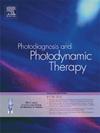ALA-PDT和伊曲康唑在治疗皮肤原皮病中的联合作用
IF 3.1
3区 医学
Q2 ONCOLOGY
引用次数: 0
摘要
背景:作为一种罕见的皮下感染,原真菌病很容易被误诊。与其他皮下感染类似,目前尚无统一的治疗标准,对于不适合手术的病例,临床医生往往根据经验使用抗真菌药物,疗程从数月到数年不等。基于目前关于光动力疗法(PDT)的相关资料和研究较少,我们根据一例临床病例进行了研究,采用口服伊曲康唑联合5-氨基乙酸光动力疗法(ALA-PDT)治疗了一名由原皮细胞瘤引起的皮肤原皮细胞瘤患者:方法:使用不同浓度的 ALA 和不同的光剂量,用菌落计数法研究 ALA-PDT 在体外抑制筚篥原癌生长的效果。我们还利用透射电子显微镜(TEM)观察了ALA-PDT处理柳穿鱼藻细胞结构的变化及其影响。此外,我们还在体外进行了ALA-PDT前后柳穿鱼藻对伊曲康唑的药敏试验:结果:我们采用联合疗法成功治疗了一名由柳条霉菌引起的皮肤原皮病患者,疗程共 9 周。在体外,当ALA浓度为5mg/mL时,ALA-PDT可抑制柳霉菌的生长(P<0.01),并且随着ALA浓度或光照剂量的增加,这种效果变得更强。利用 TEM 技术,我们证实了 ALA-PDT 能破坏柳穿鱼藻的细胞壁结构和分区结构,这可能是其抑制作用的原因之一。进一步的研究表明,ALA-PDT后,伊曲康唑对柳条菌的MIC降低:结论:ALA-PDT联合口服伊曲康唑可用于治疗皮肤原皮病。结论:ALA-PDT 联合口服伊曲康唑可用于治疗皮肤原皮病,ALA-PDT 可破坏柳叶刀孢子菌的细胞壁和分区结构,从而在体外对其产生抑制作用,且随着 ALA 浓度和光剂量的增加,抑制作用增强。此外,在 ALA-PDT 作用下,柳穿鱼藻对伊曲康唑的敏感性也有所提高。因此,我们的研究为有望治疗柳穿鱼原皮病提供了理论依据。本文章由计算机程序翻译,如有差异,请以英文原文为准。
Combinatory effect of ALA-PDT and itraconazole in the treatment of cutaneous protothecosis
Background
As a rare subcutaneous infection, protothecosis is easily misdiagnosed. Similar to other subcutaneous infection, there is no unified standard for treatment, for cases not suitable for surgery, clinicians often use antifungal drugs based on their experience, and the course of treatment varies from several months to several years. Based on the fact that there are few relevant materials and researches on photodynamic therapy (PDT), we conducted a study based on a clinical case that used oral itraconazole combined with 5-aminolevylinic acid photodynamic therapy (ALA-PDT) to treat a patient with cutaneous protothecosis caused by Prototheca wicherhamii.
Methods
Different concentrations of ALA and different light doses were used to investigate the effects of ALA-PDT on the growth inhibition of P. wickerhamii in vitro with Colony-counting Methods. And we used transmission electron microscopy (TEM) to visualize the structural changes and the effects of ALA-PDT treating on cellular structures of the P. wickerhamii. Futher, we performed the susceptibility test of P. wickerhamii to itraconazole before and after ALA-PDT in vitro.
Results
We have successfully treated a patient with cutaneous protothecosis caused by P. wickerhamii by using combination therapy in a total of 9-week course of treatment. In vitro, ALA-PDT can inhibit the growth of P. wickerhamii when the ALA concentration was 5 mg/mL (P < 0.01), and this effect became stronger as the concentration of ALA or light dose is increased. Using TEM, we confirmed that ALA-PDT can disrupt the cell wall structure and partition structure of P. wickerhamii, which may contribute to its inhibitory effect. Further studies showed that the MIC of itraconazole for P. wickerhamii was decreased after ALA-PDT.
Conclusions
ALA-PDT combined with oral itraconazole can be used to treat cutaneous protothecosis. Accordingly, ALA-PDT can destroy the cell wall and partition structure of P. wickerhamii leading to an inhibitory effect on it in vitro, and the effect is enhanced with the increase of ALA concentration and light dose. Also, the sensitivity of P. wickerhamii to itraconazole is observed increased after ALA-PDT. So our study provides a theoretical basis for the promising treatment against cutaneus protothecosis.
求助全文
通过发布文献求助,成功后即可免费获取论文全文。
去求助
来源期刊

Photodiagnosis and Photodynamic Therapy
ONCOLOGY-
CiteScore
5.80
自引率
24.20%
发文量
509
审稿时长
50 days
期刊介绍:
Photodiagnosis and Photodynamic Therapy is an international journal for the dissemination of scientific knowledge and clinical developments of Photodiagnosis and Photodynamic Therapy in all medical specialties. The journal publishes original articles, review articles, case presentations, "how-to-do-it" articles, Letters to the Editor, short communications and relevant images with short descriptions. All submitted material is subject to a strict peer-review process.
 求助内容:
求助内容: 应助结果提醒方式:
应助结果提醒方式:


